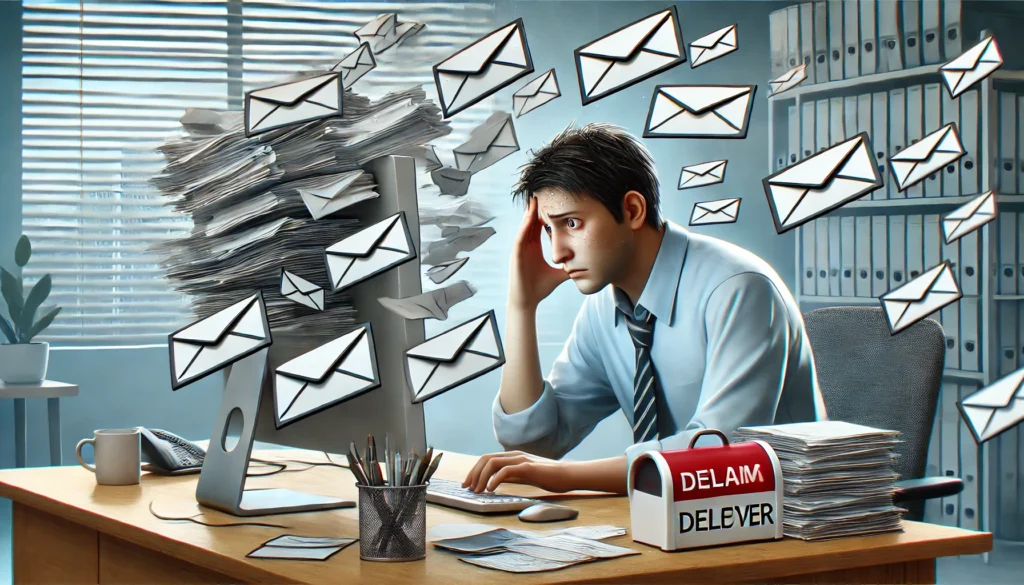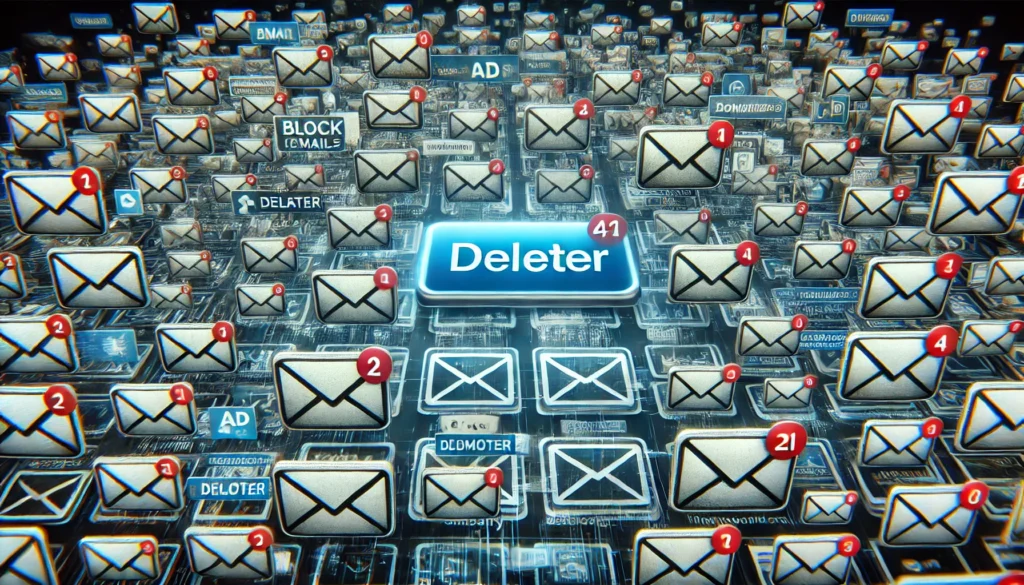Navigating through the clutter of unwanted company emails can feel like an overwhelming task. Whether it’s advertising emails, marketing newsletters, or spam, they clog your inbox and drain your productivity. In this comprehensive guide, we will explore simple and effective strategies to block company emails, ensuring a cleaner and more manageable inbox.
You may also like: Top Email Deleters for Inbox Management
Understanding the Intricacies of Email Unsubscribing
Before delving into the steps of blocking emails, it’s essential to understand the nuances of the unsubscribe process. While many promotional emails provide a straightforward “unsubscribe” link, others may not be as cooperative. This lack of compliance can be frustrating, particularly when you’re bombarded with incessant messages. However, fear not, for there are ways to regain control.
The Complexity of Spam and Junk Emails
Spam emails are notorious for their relentless nature. They often lack a legitimate unsubscribe option, making it challenging to eliminate them from your inbox. Spam emails are designed to bypass standard filtering techniques and often employ deceptive tactics to appear legitimate. This means that even the most robust filters can sometimes fail to catch them, allowing spam to infiltrate your inbox.
Moreover, clicking on dubious links can expose you to phishing attempts and malicious software. These threats can compromise your personal information, leading to identity theft or financial loss. Therefore, it is crucial to employ safe and effective methods to stop these emails.
Recognizing Non-Compliant Unsubscribe Practices
While some companies respect your choice to unsubscribe, others may use misleading tactics to retain your subscription. They might hide the unsubscribe link or require multiple steps to complete the process. It’s essential to recognize these practices and exercise patience and persistence to successfully remove yourself from unwanted mailing lists.
The Role of Email Laws and Regulations
Understanding the legal framework surrounding email communications can empower you in your efforts to unsubscribe. Laws such as the CAN-SPAM Act in the U.S. and the GDPR in Europe mandate certain standards for email marketing. Familiarizing yourself with these regulations can provide additional avenues for recourse if a company does not honor your unsubscribe request.
Simple Steps to Stop Receiving Unwanted Emails
Step 1: Unsubscribe from Legitimate Sources
For emails from reputable companies, locate the “unsubscribe” link, typically found at the bottom of the email. Clicking this link should lead you to a page where you can opt out of future communications. It’s a simple yet effective method to declutter your inbox from legitimate sources.
Navigating the Unsubscribe Process
The unsubscribe process may vary between companies. Some may offer an immediate unsubscribe option, while others might require you to log in to your account. Be prepared to follow these steps to ensure your request is processed.
Confirming Unsubscription
After you have unsubscribed, you may receive a confirmation email. It’s a good practice to keep these confirmations in case you continue to receive emails, as they can serve as proof of your unsubscribe request.
Monitoring Unsubscribe Effectiveness
Even after unsubscribing, it may take a few days for the changes to take effect. Monitor your inbox for any continued emails from the sender and take further action if necessary.
Step 2: Mark Emails as Spam
Most email providers offer a spam filter that automatically detects and diverts spam emails. If unwanted emails continue to slip through, manually mark them as spam. This action notifies your email provider to filter similar emails in the future, reducing their presence in your primary inbox.
Understanding Spam Filter Technologies
Spam filters use various technologies, including machine learning and rule-based systems, to identify and categorize spam emails. Understanding how these filters work can help you fine-tune them for better accuracy.

Training Your Spam Filter
By marking emails as spam, you are effectively training your email provider’s filter to recognize similar patterns. Over time, this can significantly reduce the amount of spam reaching your inbox.
The Limitations of Spam Filters
No spam filter is perfect, and some legitimate emails may occasionally be caught. It’s important to regularly check your spam folder to ensure important communications are not missed.
Step 3: Set Up Email Filters
Creating filters is a proactive way to manage incoming emails. Most email platforms allow you to set up filters based on specific criteria, such as the sender’s address or keywords in the subject line. By directing unwanted emails to a designated folder or the trash, you can maintain a clutter-free inbox.
Crafting Effective Filter Rules
When setting up filters, consider the specific criteria that characterize unwanted emails. This might include certain keywords, phrases, or sender addresses. Crafting precise rules can help you efficiently segregate unwanted communications.
Regularly Reviewing and Updating Filters
Email habits and sources can change over time. Regularly review your filters to ensure they remain effective and make adjustments as needed to accommodate new types of unwanted emails.
Automating Email Organization
Beyond blocking unwanted emails, filters can be used to automate the organization of your inbox. Consider creating filters for newsletters, promotions, and other categories to streamline your email management.
Step 4: Block Unwanted Senders
If certain senders persist in sending you emails despite your efforts, consider blocking them altogether. This action will prevent their emails from reaching your inbox, providing you with a sense of relief and control.
Identifying Persistent Senders
Persistent senders often use multiple addresses to bypass filters. Identifying patterns in their emails can help you effectively block all related communications.
Using Block Features in Email Clients
Most email clients offer a straightforward method to block senders. Familiarize yourself with these features and use them to prevent unwanted emails from reaching your inbox.
Maintaining a Block List
Keep track of the senders you block. This list can help you monitor and manage your blocked communications over time, ensuring that your inbox remains free from persistent nuisances.
Step 5: Use Third-Party Unsubscribe Tools
For a more streamlined approach, consider using third-party tools designed to manage email subscriptions. These tools scan your inbox for subscription emails and offer the option to unsubscribe from multiple lists simultaneously. However, ensure the tool is reputable and secure before granting access to your email account.
Evaluating Third-Party Tool Features
Different tools offer varying features, such as batch unsubscribe, email analytics, and more. Evaluate these features based on your needs to choose the most appropriate tool for managing your subscriptions.

Ensuring Security and Privacy
Before using a third-party tool, thoroughly research its security measures and privacy policies. Ensure that it does not misuse your data and that it complies with relevant regulations.
Integrating Tools with Email Platforms
Some tools offer direct integration with popular email platforms, enhancing their functionality. Explore these integrations to optimize the management of your email subscriptions.
How to Safely Unsubscribe from Spam Emails
Unsubscribing from spam emails requires caution. Avoid clicking on any links within suspicious emails, as they may lead to harmful websites. Instead, use your email provider’s built-in tools to mark them as spam. Additionally, consider reporting persistent spam emails to your email provider for further action.
Protecting Yourself from Phishing Attempts
Phishing emails often masquerade as legitimate communications, tricking recipients into revealing personal information. To safeguard against such attempts, scrutinize the sender’s address and avoid clicking on links or downloading attachments from unfamiliar sources. Your vigilance is your best defense.
Recognizing Phishing Red Flags
Phishing emails often contain telltale signs, such as poor grammar, urgent language, and unfamiliar URLs. Familiarize yourself with these red flags to better identify and avoid phishing attempts.
Verifying Sender Legitimacy
If you suspect an email might be phishing, verify the sender’s legitimacy by checking the official website or contacting the company directly. This step can prevent you from falling victim to scams.
Utilizing Security Software
Consider using security software that offers phishing protection. These tools can provide an additional layer of defense, alerting you to potential threats before you interact with them.
Long-Term Strategies for a Spam-Free Inbox
Regularly Clean Your Email Subscriptions
Periodically review your email subscriptions and unsubscribe from those no longer relevant. This practice not only reduces clutter but also minimizes the risk of your email address being shared with third-party marketers.
Creating a Subscription Audit Routine
Establish a routine to audit your subscriptions, perhaps monthly or quarterly. Regular audits help you stay on top of your email management and ensure your inbox remains relevant to your interests.
Prioritizing Subscriptions
Evaluate which subscriptions are most valuable to you and focus on maintaining those. By prioritizing, you can ensure that your inbox is reserved for the content you truly care about.
Utilizing Subscription Management Tools
Consider using tools specifically designed to manage subscriptions. These tools can simplify the process of identifying and unsubscribing from unwanted mailing lists.
Employ a Secondary Email Address
Consider using a secondary email address for sign-ups and subscriptions. This strategy keeps your primary inbox free from unnecessary communications and provides an additional layer of protection against spam.
Setting Up a Dedicated Subscription Email
Create an email account dedicated solely to subscriptions and online registrations. This separation keeps your primary email focused on important communications.
Managing Multiple Inboxes
While having multiple email addresses can be beneficial, it also requires effective management. Use email clients that allow you to view and manage multiple accounts from a single interface.
Transitioning Current Subscriptions
If you decide to use a secondary email, gradually transition existing subscriptions to the new address. This process may take time but will ultimately lead to a more organized primary inbox.
Stay Informed About Email Privacy Policies
Familiarize yourself with the privacy policies of the websites and services you subscribe to. Understanding how your information is used and shared can help you make informed decisions about your online activities.
Reading Privacy Policies Thoroughly
Take the time to read privacy policies carefully, looking for details about data sharing and marketing practices. This knowledge can guide your decisions about which services to engage with.
Monitoring Policy Changes
Companies may update their privacy policies from time to time. Stay informed about these changes to ensure your continued comfort with how your information is handled.
Advocating for Stronger Privacy Practices
As a consumer, you have the power to advocate for better privacy practices. Consider voicing your concerns to companies and supporting those that prioritize user privacy.
The Future of Email Management
As technology evolves, so too do the strategies for managing email communications. Future trends suggest a shift towards more personalized and consent-based marketing approaches, reducing the prevalence of unsolicited emails. Staying informed about these developments will empower you to adapt and maintain control over your digital communication channels.

Anticipating Technological Advancements
Keep an eye on technological advancements in email management, such as AI-driven filtering and enhanced privacy features. These innovations promise to improve the efficiency and security of your email experience.
Embracing Consent-Based Marketing
The shift towards consent-based marketing emphasizes respect for user preferences. By supporting companies that adopt these practices, you contribute to a more respectful digital ecosystem.
Preparing for Evolving Threats
As email threats continue to evolve, staying informed about new tactics and defense strategies is crucial. Regularly update your knowledge to protect yourself from emerging risks.
Conclusion
In conclusion, managing unwanted company emails requires a combination of immediate actions and long-term strategies. By unsubscribing from legitimate sources, using spam filters, setting up email filters, and employing caution with spam emails, you can regain control over your inbox. Remember, maintaining a spam-free inbox is an ongoing process that demands vigilance and awareness of current trends.
With these insights and practical steps, you are now equipped to tackle the challenge of unwanted emails, ensuring a more organized and stress-free digital experience. By implementing these strategies, you pave the way for a future where your inbox serves as a tool for productivity rather than a source of frustration.
Further Reading:
Inbox cluttered with spam? Here’s how to (safely) unsubscribe from emails
How To Block An Email Address In 2025
How to Unsubscribe From Emails Without Unsubscribe Link
Important Note: The information contained in this article is for general informational purposes only, and should not be construed as health or medical advice, nor is it intended to diagnose, prevent, treat, or cure any disease or health condition. Before embarking on any diet, fitness regimen, or program of nutritional supplementation, it is advisable to consult your healthcare professional in order to determine its safety and probable efficacy in terms of your individual state of health.
Regarding Nutritional Supplements Or Other Non-Prescription Health Products: If any nutritional supplements or other non-prescription health products are mentioned in the foregoing article, any claims or statements made about them have not been evaluated by the U.S. Food and Drug Administration, and such nutritional supplements or other health products are not intended to diagnose, treat, cure, or prevent any disease.


